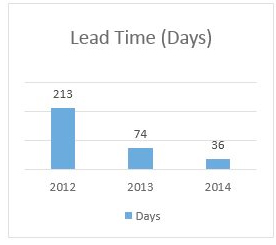 Before Lean, an Oil and Gas Engineering Firm took an average of seven months to see a project through to completion. Their project lead time was 213 days … they would agree that is a pretty gross statistic, but it was a hard reality they had to face before they could make things better.
Before Lean, an Oil and Gas Engineering Firm took an average of seven months to see a project through to completion. Their project lead time was 213 days … they would agree that is a pretty gross statistic, but it was a hard reality they had to face before they could make things better.
After starting their Lean journey, they began to see immediate improvements to many of their business metrics, but their lead time improvement was perhaps one of the most drastic. Within two years, they had reduced their project lead time by over 80% and they started completing projects in about five weeks, on average.
How did they do it? They had to start by taking a look at some hard realities in their processes and figuring out ways to fix them.
Here are some examples:
| Problem/Waste (Then): | Improvement (Now): |
| Customer demands exceeded our capacity, but we started jobs as soon as we received a PO. Planned work was getting displaced by louder voices on other new projects. | Created current and future value stream maps to improve the process, from the time we receive a customer inquiry to the time the project gets closed. |
| Some of our technical employees had more than 8 jobs on the go at any one time. | Limit WIP (work in progress) to no more than 2 projects each and those projects have to be finished before anything new is started. Each job has one project lead responsible for its success and completion. |
| There was one project board for everyone and stand-up meetings were too long. | Split project boards into small projects (<80 hrs.) and large projects (>80 hrs.). Created one dedicated team for each large project. |
| Incorrectly assumed that everyone automatically knew what to do, and what priorities were. | Created visible project queue (pictured below) that gets prioritized every day. New work is now pulled from hand offs on the project board. It makes inventory visible and prioritization easier. |
| Workloads were invisible, which made planned work susceptible to being displaced by new work. | People commit to executing their planned work. Stickie notes with time required/task show personal inventory. |
| Emergency jobs frequently disrupted our process and delayed committed work. | Instituted dedicated resources for triage events. Their priority is triage, and if there isn’t any emergency work they work on their second priority or help others. |
It’s important to mention that all of these improvements were done with the same number of employees. The old system of pushing projects through the system led to tremendous amounts of waste. Focusing on seeing one project through to completion was much more effective than having many partially completed jobs. In the end, they did not start as quickly, but they finished substantially faster.
If you are interested in learning more, contact Red-5 to learn how this paradigm towards viewing your project work could be realized within your business too.


